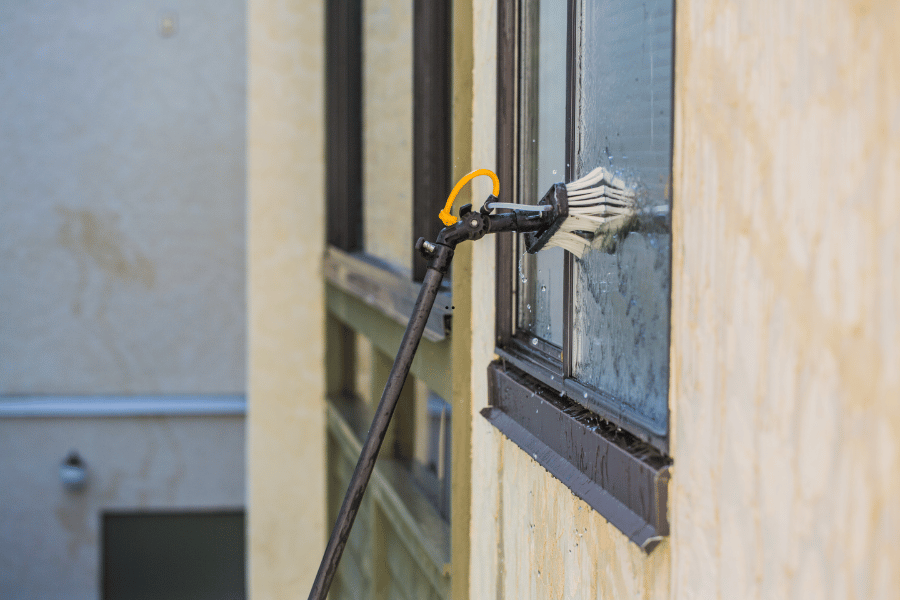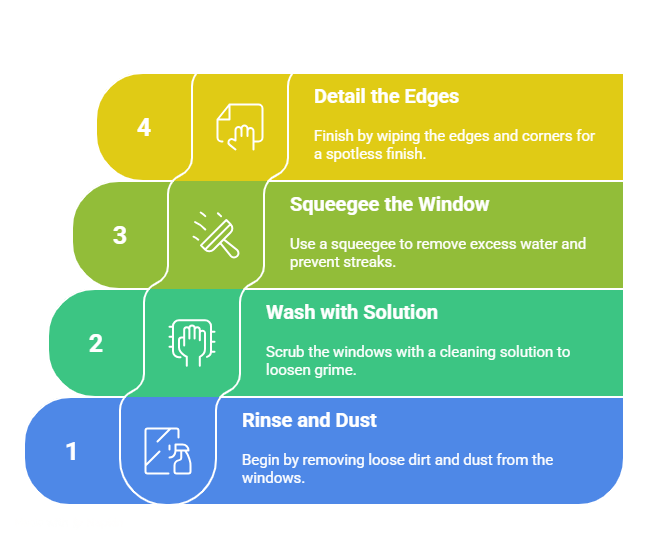
Cleaning second-story windows is doable without scaling a ladder. In fact, the safest way is to work from the ground using long-handled tools. For example, you can mix warm water and a little white vinegar in a bucket, attach a microfiber scrubber to a telescoping pole, and wash the glass thoroughly from below. Then switch to a squeegee on the pole and pull it from top to bottom to remove the soapy water. Finally, wipe any drips around the edges with a clean microfiber cloth. This method – scrubbing then squeegeeing – lets you clean second-story windows without ladders. We’ll break down the step-by-step process below, including tools you’ll need, ladder-free techniques (like water-fed poles and magnetic cleaners), and when it makes sense to call in professional window washers.
Essential Tools & Materials
Professionals often use a water-fed extension pole system to wash second-story windows safely from the ground. To clean your windows, gather the right gear:
- Telescoping window pole: A long extendable pole that fits a brush or microfiber washer on one end and a rubber squeegee on the other. This lets you scrub and squeegee from the ground.
- Cleaning solution: A bucket of warm water with a little dish soap or white vinegar is ideal. (Experts recommend about 10 parts water to 1 part vinegar for a streak-free finish.)
- Backup bucket: Keep a second bucket of plain clean water for rinsing the brush or pole between windows.
- Lint-free cloths: Microfiber towels are perfect for wiping sills and drying edges after squeegeeing.
- Protective gear: Work gloves and safety glasses keep you comfortable. If using any ladder (only if necessary), have someone hold it.
Some other handy items: a garden hose for a quick pre-rinse, a small step ladder (used very carefully), and a magnetic window cleaner if you have sliding or fixed panes you can’t reach at all. (A magnetic cleaner is two pads, one for inside and one for outside – move the inside pad and the outside follows along.) These tools will let you wash the glass from below, minimizing risk.
Step-by-Step Cleaning Process

- Rinse and dust: Start by removing loose dirt. Use a garden hose or spray from your pole to wet the windows and loosen dust. If you have access from inside, vacuum or wipe away cobwebs and dirt on the frames first. (Always rinse before scrubbing to avoid grinding grit into the glass.)
- Wash with solution: Dip the brush/washer on your pole into the bucket of cleaning solution (water + vinegar or mild detergent). Scrub the window glass in even strokes, working from top to bottom. Be thorough – loosen pollen, grime and bugs.
- Squeegee the window: Swap the pole attachment to the rubber squeegee. Starting at one top corner, pull the squeegee down in a smooth vertical stroke. Wipe the blade with a towel after each pass, and overlap each stroke slightly to avoid lines. Continue until the pane is mostly dry. (Many pros use a ladder only for a final inspection to catch any missed spots.)
- Detail the edges: Use a clean microfiber cloth to wipe around the edges and corners of the window, catching any drips or streaks left behind. Check the window from different angles (move around) to make sure it looks clear. Your second bucket of plain water can help rinse the scrubber or pole between windows, so you don’t reintroduce dirt.
Following this process – rinse, scrub, squeegee, dry – will leave your second-story windows crystal clear. It’s basically the same method used by professional cleaners, but done from solid ground.
Ladder-Free Cleaning Methods
You don’t have to (and shouldn’t) balance on a ladder for high windows. Here are safer alternatives:
- Water-Fed Pole System: This is a long pole with a brush on the end that attaches to a hose and water tank. As you scrub the glass, purified water flows through the pole, rinsing away dirt in real time. Because the water is filtered, it dries without spots, so you often don’t need to towel-dry at all. Many window pros (including local ones in Columbus) use water-fed poles for upper-story windows – Lumen Company notes they use an ionized water system to clean hard-to-reach windows safely. It’s an efficient way to wash second-story panes from the ground.
- Telescoping Brushes and Squeegees: For standard double-hung or casement windows, a simple telescoping pole kit works great. These pole tools (usually 10–20+ feet long) fit into most hardware stores. Look for a kit with a brush sleeve and a T-bar squeegee that screw onto the pole. This is the simplest DIY approach and is often cheaper than the full water-fed rig.
- Magnetic Window Cleaners: If you live in an apartment or have a fixed-pane window you can’t open, a magnetic cleaner is handy. It has two strong magnets – one on each side of the glass. You spray the solution on both sides, attach the magnets (inside/outside), and move the inner magnet pad. The outer magnet follows and cleans the outside simultaneously. Always keep the safety string on the exterior magnet to prevent drops.
- Safe Ladder or Scaffold: If absolutely needed (for example, very high or oddly shaped windows), use a sturdy ladder or rolling scaffold. Safety first: make sure it’s on level ground, have a helper hold the base, and don’t lean or overreach. Lumen Company and other pros note that climbing with makeshift setups can be dangerous on multi-level homes. If you must use a ladder, consider wearing a safety harness and never work alone.
Each of these methods avoids scrambling on precarious footing. In general, using extension tools and purified water is preferable to ladders.
Best Conditions & Safety Tips
Timing matters. Window cleaners recommend choosing a mild, overcast day. Direct sunlight can make your cleaning solution dry too fast and leave streaks; a cloudy sky keeps the surface damp longer so you can squeegee cleanly. Also avoid cleaning when rain is in the forecast – you’ll wash all your work away and possibly get streaks from hard water spots.
A few more tips for safety and quality:

- Work from left to right: When squeegeeing, wipe the blade from top to bottom and then move over slightly to the right or left. This prevents cross-marks.
- Protect your hands and eyes: Wear gloves and goggles, especially if using strong cleaners or high-pressure washers.
- Watch for hazards: Don’t stand in water or on slippery surfaces. Keep cords and hoses organized. If using a hose-end pressure jet, use the lowest safe setting for glass.
- Check frames and tracks: While you’re up there (figuratively), use a cloth to wipe sills and tracks; dirt on frames can transfer to the glass. Vacuum debris first if possible.
Being prepared and patient makes the job go smoothly. With the right conditions and equipment, you can achieve streak-free second-story windows on your own.
When to Call in the Pros
Sometimes it’s best to let experts handle upper-story windows. Professional window cleaners (like Lumen Company Ohio) arrive with insured teams and specialized gear. For instance, Lumen emphasizes that their trained crew uses a water-fed pole system with purified water to clean windows up to three stories tall safely. They point out that using ladders on multi-level homes is risky and time-consuming, so their method keeps everyone on solid ground.
Hiring pros has advantages: they save you time and effort, and they often guarantee streak-free results. As Lumen notes, window cleaning looks simple, but DIY attempts often leave smudges or miss tricky corners. A professional team can finish the job in far less time (so your weekend isn’t eaten up with squeegeeing) and handle the nooks and frames you might overlook. Plus, if you schedule a service, they bring their own supplies – you just enjoy the clear view.
In short, whether you do it yourself or hire help, the key is to avoid unnecessary risks. Using extension poles or water-fed systems lets you clean high windows without ladders. And if the job seems too big or dangerous, local pros like Lumen Company have the experience and equipment to make those second-story windows shine safel.

